Antibiotic Use for Safe Food Production

Antibiotic use in livestock has been a hot topic, but are those animals still safe to eat?
By: Heidi Carroll and Russ Daly, SDSU Extension
The discovery of antibiotics began in the 1920’s and continued through the decades providing a wide variety of substances to fight bacteria that caused sickness and disease in people and livestock. However, antibiotic resistance and the potential of antibiotic residues in meat, milk, or eggs are concerns to families. This article will summarize some of the main questions about antibiotic use in cattle production that are discussed in detail in Beef Procedures: Antibiotic Use.
Antibiotics are given to cattle to relieve pain and distress associated with illness and to promote a quick recovery back to health. Medicines can be administered with injections (shots) under the skin or in a muscle, with pills, in feed, or in water. Timely administration of antibiotics may help minimize secondary problems occurring from illness. In some cases, animals that are in danger of becoming sick because of stress or exposure to new environments may be administered antibiotics to prevent sickness or infection. It is important to remember that antibiotics are only effective against bacteria, not viruses, parasites, or other agents. Some antibiotics help cattle grow faster and gain weight more efficiently on the feed they eat. They are typically included in the feed as growth promoters instead of injected and are given at lower concentrations than when used to treat an illness. Not all livestock producers choose to use antibiotics to aid with growth and the decision may be evaluated with a veterinarian or nutritionist, and ultimately determined by the intended market of the meat produced (see links below for more information about using antibiotics).
Cattle can be raised in different environments and husbandry systems throughout their lives. Cows and their calves may live on wide-open grasslands, and in other parts of the United States, in smaller lots depending on the climate and feed resources available. When calves are weaned, they may enter a feedyard, or stay on pasture. Nevertheless, cattle can get sick and stressed in any of these husbandry systems, so producers use antibiotics as part of their management strategy to maintain optimal health and well-being. When a sick animal is identified for treatment, producers keep records to track the animal and the inventory of the medicines being used on the ranch.
The Food and Drug Administration (FDA) dictates the approval of and directions for use of antibiotics in livestock. The FDA’s regulations ensure the proper use of these products and maintain a safe beef supply. A safe beef supply is achieved by producers following strict withdrawal periods when they use medicines. A withdrawal period is the minimum acceptable time elapsed after treatment that ensures the animal has metabolized the drug to a low enough concentration that the meat (or milk or eggs) will be below the FDA’s tolerance. There are also residue tolerances for pesticides set by the Environmental Protection Agency (EPA) to ensure the products used for pest control on cattle do not end up in the food supply. The Food Safety and Inspection Service (FSIS) randomly samples and tests meat at slaughter facilities to add another level of safety to the food supply. Fines and prison time are possible for people selling animals with levels of antibiotics over the FDA limit, but the number of violations is extremely low. All violations are published regularly on the FSIS website.
The United States’ food supply is one of the safest food supplies in the world. Our safe food supply is maintained when livestock caretakers use antibiotics responsibly based on FDA regulations in cooperation with veterinary guidance. Our food supply is verified safe by the FSIS inspections for residues or defects in the meat before it is sold to consumers.







